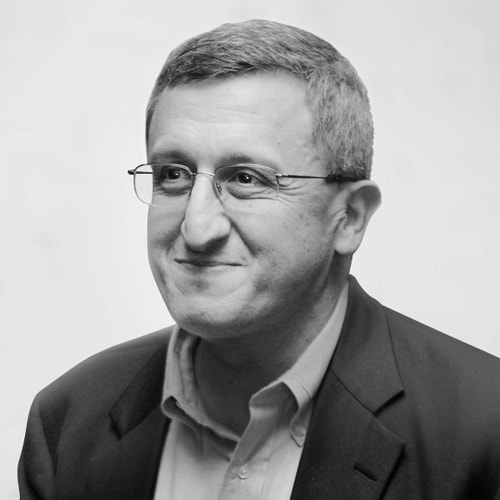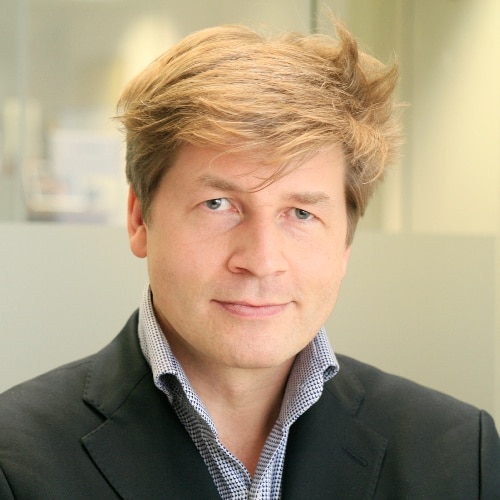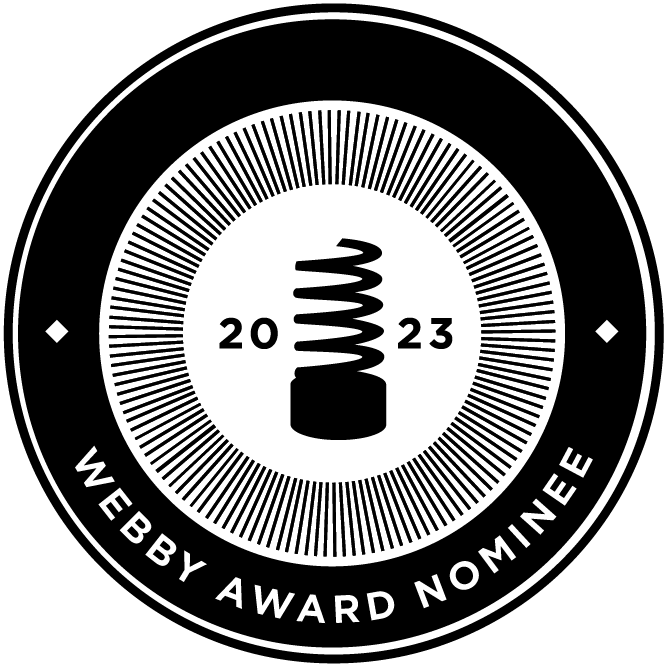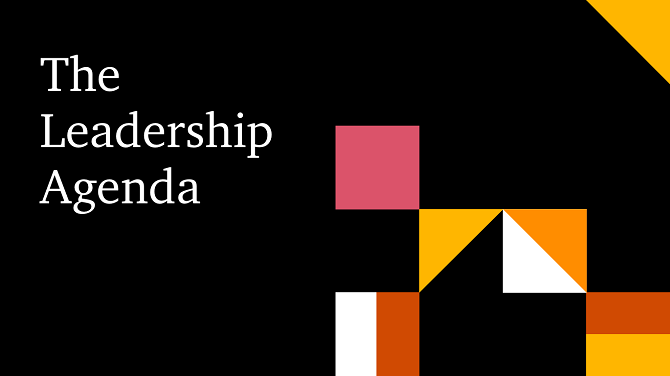{{item.title}}
{{item.text}}

{{item.title}}
{{item.text}}
Take on Tomorrow, the award-winning podcast from our management publication strategy+business, brings you Episode 2: “How can humanity jump-start breakthrough innovation?”
What is the biggest obstacle to innovation in any organization? Why should innovators avoid free-form experimentation to focus on realistic objectives? How can companies use innovation to solve problems without creating new ones? In this episode, we’ll hear how businesses can benefit from making innovation more inclusive, enabling developments across every sector, and finding innovation within every employee.
Lizzie O’Leary
Podcaster and journalist
Ayesha Hazarika
Columnist and former senior political advisor
Ken Gabriel
COO Wellcome Leap, former Acting Dir. of DARPA
Leo Johnson
Head of Disruption & Innovation, PwC UK
2023 Webby award nominee for "Best Podcast" series
The April issue of s+b explores how companies can reduce their energy consumption by 31% by decade’s end and save a cool US$2 trillion a year—without sacrificing growth.
Sharp, actionable insights curated to help global leaders build trust and deliver sustained outcomes. Explore our latest content on the global issues affecting organisations today from ESG to value creation, technology and cyber to workforce transformation.
Ken Gabriel: Now here was this little pip-squeak organization, 0.5% of budget, saying, “We’re going to build a slower aircraft, less maneuverable.” But what the Air Force didn’t see was the fact that, yes, it would be slower and less maneuverable, but it would be invisible, nearly invisible on radar.
This is what I mean by disciplined innovation. And, often, the biggest detractors or the biggest opponents—obstacles—to that innovation are internal.
Leo Johnson: You know, technology is not the answer. It’s the amplifier of intent. And the fundamental question, I think that all of us are confronted by is, like, what is the intent? What is the world that we want to try to help shape?
Lizzie O’Leary: Hello, and welcome to Take on Tomorrow, a new show from PwC’s management publication strategy and business. I’m Lizzie O’Leary, a journalist in New York.
Ayesha Hazarika: And I’m Ayesha Hazarika, a columnist and former senior political advisor in London. Today, we’ll be talking about breakthrough innovations, not just big ideas, but how to create an environment which allows those life-changing ideas to happen.
Lizzie: And in order to do that, we need to think about how companies and organizations are structured. We’ll be speaking to Ken Gabriel, the COO of Wellcome Leap, a nonprofit that helps organizations collaborate on research.
Ayesha: But before Ken came to work for Wellcome, he was leading one of the world’s most influential research organizations, DARPA, the Defense Advanced Research Projects Agency. It brought us the internet, GPS, drones, and even our good friend, Siri.
Lizzie: We’ll hear more about Ken soon. But first, I want to say welcome to Leo Johnson, head of disruption and innovation for PwC UK. Hello, Leo.
Leo: Hello, lovely to be with everybody.
Ayesha: “Head of disruption and innovation” is a very interesting title. But what exactly does that mean your job is?
Leo: I’m suddenly thinking I’ve got no straightforward answer. I’ve got no 15-seconds soundbite. I think we’re trying to make good stuff happen. And the stuff that my job focuses on is the stuff that disrupts not just business models but power dynamics—and helps to address some of the fundamentals of the environmental and the social and the governance challenges. In other words, it’s the “and,” it’s the innovation that really is focused on the big problems.
Ayesha: It’s so interesting, because when one thinks of innovation, and you have this very cool title, I sometimes think of a James Bond film, and Q, and coming up with lots of whizzy ways of doing things. I mean, how is your job practically handled? Are there lots of people in laboratories thinking of innovative, crazy, mad ideas?
Leo: We’re in this amazing spot, which is we’re engaging with the ecosystem. And right now, we’re doing this huge focus on net-zero innovation.
Lizzie: What’s net-zero innovation?
Leo: So, it’s companies that are helping to suck out the carbon that we need to, we need to decarbonize now at 12.9% a year, five times faster than we have been doing in the last 20 years, if we’re going to avoid more than 1.5 degrees of warming. And “net-zero innovation” is the climate tech entrepreneurs who are figuring out how to bend that arc and accelerate the rate at which we’re sucking carbon out of the system.
Lizzie: And when you have conversations, what are the most exciting and interesting ones you’re having right now?
Leo: Part of what we’re trying to hack away at is this dynamic where we’re calling it the carbon and funding gap. Which is, some sectors are basically getting all the funding. And even though everything needs more funding, they’re getting a disproportionate amount of funding relative to their carbon emissions.
So, in particular, mobility, batteries, electric vehicles, they’re eating all the pies. Mobility is getting 60% of the funding, and it’s about 16% of total emissions. So we’re trying to find the innovators that are addressing that carbon funding gap. But another thing we’re looking for is trying to figure out how can we help rewire to enable startups to have impact around some big, knotty problems. And that’s where some of the really fun stuff is happening.
Ayesha: Do you think policymakers really understand what innovation is? And do you think they understand the environment that sparks innovation and what nurtures innovation?
Leo: I think that we have to go back to this question of what are we trying to solve for. What’s the outcome we’re trying to create? And that’s what the policy needs to be guided by. Innovation is a means to some outcomes we’re after.
And I’m reminded of that great quote from Kentaro Toyama, [when he was] Microsoft research director, who says technology is not the answer. It’s the amplifier of intent. And the fundamental question, I think, that all of us are confronted by is: what is the intent? What is the world that we want to try to help shape and co-create? What does it look like?
Ayesha: Leo, do stick around, because we’re going to come back to you shortly. But first, we’re going to hear Lizzie and Ken Gabriel’s conversation about the past, present, and future of innovation.
Lizzie: Ken has worn a lot of different hats. He started his career at Bell Labs, a legendary research institution, and later became president and CEO of Draper Laboratory, an MIT spin-off that developed the computers that guided Apollo 11 to the moon. But before he landed his present role as COO at Wellcome Leap, Ken was deputy director, then acting director of DARPA. And DARPA has a very special way of doing things.
I grew up in Washington. And in Washington, you’re always accountable to someone. You are always constrained by budget. And I always had this image of DARPA as a place where people didn’t have to have that, where they got to be smart and creative and really invent crazy stuff. Is that accurate?
Ken: It is. But with what I would say, the way to think about it, Lizzie, is, it is disciplined innovation. People are free to explore some seemingly impossible ideas. But with discipline, and what I mean by “with discipline” is you’re not allowed to just say, “I want to do a program in this area; we’ll see what happens.” No. What you do is every program starts out with what I would describe as bold but believable objectives.
For an example, historically, stealth came out of the DARPA in the ’70s. Stealth technology in general, yes, but ultimately stealth fighter, stealth bomber. Now, the challenge at the time was that challenged the worldview, because for decades, the way the Air Force and the US had advantage was faster and more maneuverable planes. Now, here was this little pip-squeak organization, 0.5% of budget, saying, “We’re going to build a slower aircraft, less maneuverable.”
But what the Air Force didn’t see was the fact that, yes, it would be slower and less maneuverable, but it would be invisible, nearly invisible, on radar. And this is where some of the tension happens all the time. I had the opportunity to speak with a director of the agency back in the ’70s. And the Air Force actually tried to zero DARPA’s budget for that program. Not because they were stupid or mean. It’s because their view was, if it’s not faster and more maneuverable, it’s not right.
Lizzie: Let’s rewind a bit. Can you just explain for anyone who doesn’t know what DARPA and ARPA are?
Ken: DARPA is Defense Advanced Research Projects Agency. ARPA is the same thing except for the defense part. And it flips back and forth, but it’s the same organization. It was formed in response to Sputnik in 1958. It surprised the United States that the Soviets sent up a satellite. And the reality was that the US had the appropriate rockets, they had the appropriate avionics to have launched a satellite well before Sputnik. But things had been stove-piped, and different parts of the DOD, Department of Defense, were not talking to each other.
So it was an opportunity not just to create innovations but to change the way that innovations were made. So let me give you the quick three-element basis of what I consider the ARPA model of innovation to be.
One is programs which have bold but believable objectives that are capability-focused, as I talked about. We don’t talk about science. We talk about being able to do something at the end of a program that we couldn’t, and that matters.
Second element is strong technical leaders, program directors, who orchestrate an outside group of performers. They fund outside groups of performers—universities, nonprofit, research, small companies, big companies, individuals, whomever and whoever has the skill set to contribute individually. Collectively, this group of performers achieves what no one performer alone could achieve. So, bold objectives, strong program manager with outside performers…
Third is fixed duration and budgets. All of our programs are three years long. And, generally speaking, there’s no rule: 50 million, plus or minus ten, over three years. So why that third piece? When you have a fixed duration of budget, you create a sense of urgency and focus.
Lizzie: I’m struck by the small size of DARPA. And I wonder if this stuff gets harder, the larger an organization gets and the more money is at stake.
Ken: Yes, you’re absolutely right. That is one of the secrets of DARPA. It has always been 0.5% of the budget. And there’s always only ever been about 100 program managers, the people who actually manage these efforts. And because we’re so small, there’s only one layer of management between the program managers and the leadership of the agency.
Lizzie: Listening to you describe this, it makes so much sense. It sounds so cool. But most companies, big companies, or companies that are accountable to shareholders have a very hard time taking that step, imagining something that is outside the box of their regular thinking. I wonder, given your experience both in the public sector and in the private, how do you take that kind of thinking and translate it onto a company?
Ken: Great question. The way to translate this to a company is to look at what is the company’s business, in the same sense that, in a way, what was the Air Force’s business? Air dominance, right? And what are the different ways and different products and services that make that happen? So in many ways, what needs to happen inside of a company, you have to have clarity about what the objective is.
This is what I mean by disciplined innovation. And, often, interestingly enough, the biggest detractors or the biggest opponents—obstacles—to that innovation are internal. Because if you’re disrupting a product or a service, you’re disrupting someone’s P&L, you’re disrupting an existing business. But if you don’t do it, you risk dying. Look at the difference between Netflix and Blockbusters.
Lizzie: So Reed Hastings says, “Hey, we need this thing to be streaming.” But that disrupted their business model of mailing movies.
Ken: Right. But if they had only focused on, “I don’t want to disrupt my mailing of movies,” they would have died.
Lizzie: And yet, I feel like innovation is this word that gets tossed around. All companies want it. You hear it talked about in Silicon Valley. But it’s so gauzy. Like, how do you get past gauzy into real?
Ken: Innovation has become a word that has become imprecise. And I’m going to focus on a couple that are really important. One is innovations in understanding and discovery, which is typically sometimes the discovery-driven research, basic science. On the other side, you have industry, the private sector. What are their innovations? They’re about scaling the delivery of services and goods. Those innovations, though, are not the same as breakthrough innovations.
Lizzie: What’s that?
Ken: What I mean by breakthrough innovations: innovations that change the game. And typically, those innovations require you to integrate, bring together, exponential trends from different areas, and keep them together long enough to do that demonstration and convincing scale.
Lizzie: I wonder if you could zoom out a little bit for me and give us a report card. How is global industry? Or if you don’t want to think about industry, maybe countries doing on this scale. Are we in an innovation boom? Are we moving too slowly? When you look at how these parts come together, how do you feel about it? Are we doing OK?
Ken: I would say, in terms of evolutionary improvements on our internet access, our Wi-Fi systems, our phones. Those are happening regularly. I’m happy with them. Collectively, they get better and better and better. It’s not so much that there’s something wrong, that there are certain areas where we believe it’s not happening fast enough. And health is one of those areas.
So this is why Wellcome Trust, the second largest philanthropic organization dedicated to healthcare, decided to create and try the ARPA model. Which is what you can think of Wellcome Leap, as it’s an international ARPA for global health. I would say in certain sectors, as we’ve seen with the pandemic, there are some problems that are not national.
And most ARPAs are very national. Our ARPA is necessarily national because it’s national security. The UK has their own, the Germans have their own ARPA. But everybody wants their own ARPA, but they’re all focused nationally. But there’s certain problems like health that aren’t national, that are global.
And not only is it global on impact, but it’s also a bit of hubris to think we’re the only ones in the US who have people who know how to contribute to this. The global commons is actually rich, and that’s why part of what this model, you’ve been right to observe, so all of our programs now are international in scope. Wellcome Leap programs have international performers—they’re not just US or UK performers—on six continents right now.
So I’d say it’s less about, there’s a problem with innovation, and more that in particular areas, specifically health, we need breakthroughs faster, and more of them.
Lizzie: Innovation in healthcare feels different. There’s something emotional about it where people get nervous, and I wonder how you have navigated that, particularly in your new job. Do people seem more fearful when you’re dealing with health innovation?
Ken: Well, that’s a great question, it has many dimensions through it. First, I will say, for the people who are suffering from the diseases or conditions, they can’t get it fast enough. But there is also a perception, I would say, based on the way we have done things traditionally, that speed of innovation in healthcare equals bad. Right? We don’t question that, in three months, I’m going to get another different one of these and it’s going to be faster.
Lizzie: You’re holding up your phone.
Ken: Yes. I’m holding up my phone. We don’t question that. “Bring it on faster, the better, more. I have no doubts. I have no qualms.… Wait a minute. You developed a vaccine in five months instead of three years?” Now, you create all this vaccine hesitancy and others.
So, I think there is an amount of education that has to happen about healthcare. What is it about healthcare that makes it difficult? What is it about developing therapeutics that we should be worried about? There is some rational, reasonable concern, but there should not be a rejection of technologies once we can demonstrate what is it that it is doing.
Lizzie: Let me push you on this a little bit, because I think one of the things that makes this hard is, if you have been on the receiving end of the healthcare system, it can be paternalistic and difficult and siloed, and you don’t get a lot of information, so it’s hard to take a leap of faith. And I wonder how someone like you can get the buy-in of people who have been on the other end of this to remove that element of fear, to create trust and partnership.
Ken: Yeah, I think this is going to require a fundamental change. There’s an onus on the population to at least try to understand what’s happening. And also an onus on the people developing the technology to make it approachable and understandable. Some of the things that we’re doing in terms of what’s next is MRNA. Right now, MRNA technology is fantastic, but it still takes time for it to get up to manufacturing, as we saw. And every RNA-based therapeutic has its own bespoke process, which is three to 500 million [dollars] of expense in setting up.
It doesn’t need to be that way. In fact, if you go back to the ’50s, microelectronics was exactly the same way. For every chip that was made, it had a bespoke fabrication process. But the microelectronics industry doesn’t function that way. It is the so-called platform technology now, because the design of new chips got decoupled from the fabrication, and you could make many different chips off of the same fabrication flow. You can bring that to RNA production.
There’s no reason, again, in that style of, is there any reason why this shouldn’t work? Right? We can make more diverse and more RNA products off of the same manufacturing technology. What does that mean? It means we can develop new therapeutics faster, more diverse therapeutics, and for less cost, because we’re distributing the cost of the manufacturing, that manufacturing line on multiple products instead of just one.
But this is where an organization like Leap, who know the power of keeping things together long enough to demonstrate. We’re not going to be the ones that scale it. But we have enough resources and discipline and focus to say in one of our programs, we’re going to bring people who are developing new approaches to fabrication that will lend themselves to this multiple RNA common process.
We’re going to develop the design tools, the abstractions, the digital design tools, the digital twins for the manufacturing and put all of them together to demonstrate that this can be done. Once it’s demonstrated, I think, like electronic imaging, like the internet, like other things, it will change the way MRNA therapeutics are done.
Lizzie: Ken Gabriel, thank you so much for talking with me.
Ken: Pleasure. Thank you. I’m glad we were able to connect.
Ayesha: So, Leo, what were your big takeaways from Ken Gabriel and the DARPA model? And, in your experience, how often does business employ this kind of model that he’s talking about?
Leo: Brilliant to hear him, and it totally resonates, the impact that the government can have in terms of shaping and unlocking innovation. But I think it for me also amplifies this crucial question around intent, technology as the amplifier of intent. And the conversation around healthcare for me really took to the point here.
If you look at covid, the extraordinary unexpected spin-offs from it, that we’ve now got the potential for an MRNA vaccine for cancer, for malaria. What’s the intent with which we are going to deploy that technology? If you look at the deployment of covid vaccines, the percentage of people in emerging markets, in developing countries, who actually received the vaccine: 11%. For all this technological potential, are we going to deliver it with the intent to solve the problems that are out there?
Ayesha: Leo, you’ve made this really, really interesting point about the balance between the climate crisis and capitalism and the need for growth. Do you think that a lot of venture capital is more interested in growth rather than doing the right thing by climate change?
Leo: It’s such an interesting moment, where you’re seeing this growth of impact investment community, for sure, which has clearly got blended returns right at the core of its mandate. By which I mean, not just the financial, but the financial blended in with the environmental and the social, and they’re happy in that blend.
But you’re also increasingly seeing that this is where the growth is. That if you are looking for the conventional unicorns, if you look at what Larry Fink of BlackRock is saying, he’s saying the next thousand unicorns are going to be climate unicorns. We’ve seen over the last three years, as we’ve been tracking the numbers, just a real acceleration of the growth of the VC funding.
The next phase, of course, is the growth funds of private equity moving into the—as these companies go into the Series A class, Series B, and the later stage—bigger ticket investment as well. So it’s right at the cusp in terms of the VC market.
Lizzie: How does one make that acceleration happen? Get those breakthrough technologies from being early-stage investments to being something that a company puts their money behind?
Leo: Give them the capital runway, for sure. That’s the easy bit. But then the hard bit is getting this product market fit. Where you get the anchor corporate client who could really scale up that packaging innovation or that battery innovation or that zero-emissions jet fuel—to get them to integrate it into the business. And then the moment you’ve got that, you become de-risked, you become bankable, you become scalable.
The last challenge is, of course, to then get those policy moves to help unblock. And the biggest one of them all is, of course, carbon.
Lizzie: I think a question that seems important is how to use technology, or create new technologies, to solve problems instead of creating new problems or shunting problems onto other people. People who don’t have as much social capital, people who don’t have as much political representation. How do you make that work?
Leo: For me, there is something here around power, which is very important. Which is, who’s holding the means to innovate? Because that will shape what that technological innovation is deployed to do. And whether it’s creating something that addresses a local problem or is a centralized, top-down distant approximation: “Yeah, I think what these people in Kenya really need is this.” And actually doesn’t, and of course, has a history of creating these unintended consequences, these by-products. And here, I think I’m really struck in the conversation with Ken that he refers to the social dilemmas and the challenge of inequality.
I would throw out a very different model of innovation, which is the shanzai model, which is the Chinese model that came out of Shenzhen. Which were the, they were the imitators, who were counterfeiting. And they were then the imitators who became the innovators, who Jack Ma of Alibaba said, we’re actually better technically and technologically than the original companies. And what’s their principle of innovation? It’s open, open, open. It’s based on the idea that IP does not exist as a barrier. That the moment it’s out there, it’s gone.
And it’s not about trying to create this moat or this fortress wall around you. It’s about your competitive advantage is the opposite rather than your insularity. It’s about your connectedness and how much you’ve created an ecosystem that’s deploying your innovation at speed and scale. And what that shanzai model has produced is some extraordinary effects.
Part of them, in fact, as the BRI, the Belt and Road Initiative, has gone throughout parts of Africa as part of the Chinese 14th five-year development plan. You’ve seen countries like Ghana and Ethiopia, where these shanzai models have created extraordinary hubs of innovation.
Ayesha: You’ve talked about having the right kind of people, the talent, people who can think outside the box, who are not in the corporate soup, as you describe. How do you find and identify and nurture that talent?
Leo: I think we’ve all got it. I think there’s a huge crushing of our own intelligence and intuition and intent that we inflict on ourselves the moment we enter a corporate universe. There’s this process where we think, right, I’ve got to align myself with what this corporation wants. There’s a shrinking of our own values into the value system. And we all then live in this strange sort of gray zone of dissonance, with this decoupling of our own passions from the corporate project.
And I think we’re at this moment where the world, our own sanity, and even our companies need us to undo that. And to look at integrating our own value set with that of the company. It’s not about shrinking our values, it’s about expanding that of the company so that it actually becomes this thing that solves problems. It’s all about us, I think. And us realizing that we are standing in front of this open door.
Ayesha: Leo, it’s been such a fascinating conversation. Thank you so much for all your really interesting insights. Thanks for joining us.
Leo: Brilliant to talk to you. Thanks so much for having me on.
Ayesha: That was such an interesting conversation. I did not think innovation could be so creative, as I thought it might be quite dry in many ways. But what was interesting is he was challenging a lot of sort of orthodoxies about business and growth and capitalism. What’s your takeaway?
Lizzie: I was totally struck by that. I think the idea also that innovation itself can be this gauzy word that people hide behind without taking a critical look at their own systems or their own ways of thinking was incredibly compelling to hear.
And I thought about the idea of finding it within yourself or within your people, within your employees, as opposed to letting yourself walk into a company or a corporate environment and just taking on the mantle of what they want. That was super interesting to me, as well as trying to make sure that models of innovation don’t repeat elitist colonialist practices that have excluded so many people from the benefits of technology.
Ayesha: Yeah, I think that last point really chimed with me as well. And his idea of really coming together to share ideas, because ideas don’t just reside in one hemisphere of the world. We can all collaborate. We can all share ideas. We can all benefit from sharing ideas and also loosening the grip on some of the obstacles around sharing those ideas, around intellectual property rights. Quite a controversial thing to get into, but a very challenging proposition for us to think about.
Lizzie: Not one that I am expecting would be an easy sell to a lot of people, because they do want a return on capital, and IP is something that can ensure that. But I think it was really fascinating to try to push the envelope on thinking about that.
Lizzie: That’s it for this episode.
Join us next week, when we’ll be asking:
How can business prepare for the next disaster?
Guest: This tendency that everybody thinks in disaster movies that, you’d have this action figure like Tommy Lee Jones in Volcano, where one person has all the answers that makes all the decisions. It turned out that actually slows down and gums things up.
Lizzie: Take on Tomorrow is brought to you by PwC’s strategy and business. PwC refers to the PwC network and/or one or more of its member firms, each of which is a separate legal entity.

Global Clients & Industries Leader, PwC United Kingdom
Tel: +44 (0) 7590 353852






